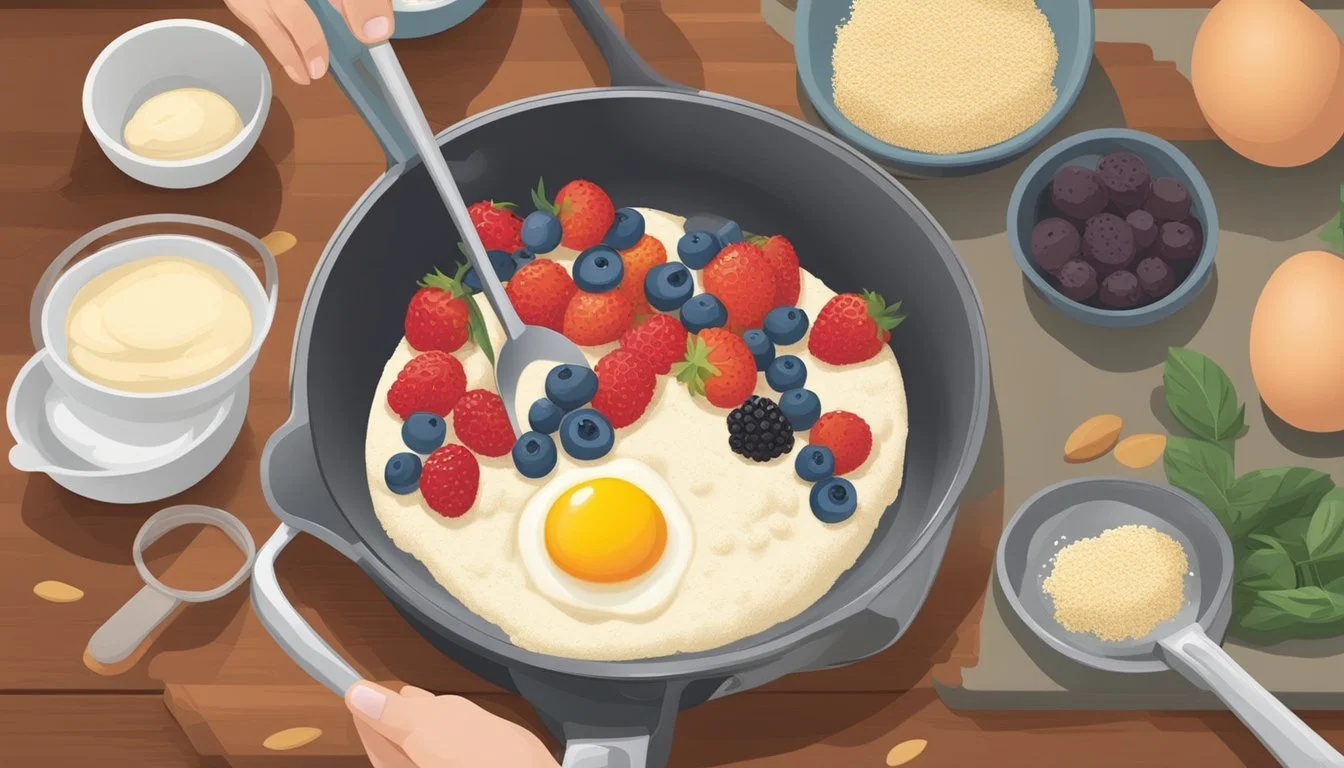4 Diabetes-Friendly Pancake Recipes
Healthy and Delicious Breakfast Options
Pancakes are a beloved breakfast staple, but finding recipes that align with a diabetes-friendly diet can be challenging. For individuals managing diabetes, it's essential to approach meals with a focus on maintaining balanced blood sugar levels while still enjoying delicious food.
This article will explore four diabetes-friendly pancake recipes that are both nutritious and flavorful. These recipes utilize wholesome ingredients and thoughtful substitutions to ensure that everyone can enjoy a stack of pancakes without the worry.
1) Almond Flour Pancakes with Stevia
Almond flour pancakes with stevia offer a delicious, low-carb option for those managing diabetes. Almond flour, made from finely ground almonds, is low in carbohydrates and high in protein and healthy fats. These nutrients help regulate blood sugar levels.
To make these pancakes, start by combining almond flour, baking powder, and a pinch of salt in a bowl. In another bowl, whisk together eggs, unsweetened almond milk, and a few drops of liquid stevia for sweetness without added sugar.
Once mixed, gradually incorporate the wet ingredients into the dry ingredients until a smooth batter forms. Preheat a nonstick skillet over medium heat. Pour about ¼ cup of batter per pancake onto the skillet.
Cook the pancakes for 3-4 minutes on one side until bubbles form around the edges. Flip and cook for another 2-3 minutes until golden brown. Serve immediately with fresh berries or a sugar-free syrup for a diabetes-friendly breakfast. This easy recipe provides a nutritious start to your day without spiking blood sugar levels.
2) Greek Yogurt Pancakes with Mixed Berries
Greek yogurt pancakes with mixed berries offer a nutritious start to the day. These pancakes incorporate ingredients that are both healthy and delicious.
To create these pancakes, begin by mixing Greek yogurt, eggs, and vanilla extract in a bowl until smooth. It's important to ensure that the mixture is well-blended.
In another bowl, combine oat flour, all-purpose flour, baking powder, baking soda, salt, and cinnamon. Whisk these dry ingredients together.
Pour the wet mixture into the dry ingredients. Stir them until they are just combined; a few lumps are acceptable. After the batter forms, gently fold in mixed berries of your choice.
Once mixed, pour the batter onto a heated griddle or pan. Cook until bubbles appear on the surface, then flip and cook until golden brown.
These pancakes are a delightful way to incorporate protein and fiber while keeping the meal low in sugar. The mixed berries add a burst of natural sweetness and additional nutritional benefits.
This simple recipe makes about 8 pancakes, perfect for serving a crowd or meal prepping for the week.
3) Cinnamon Oatmeal Pancakes with Walnuts
Cinnamon oatmeal pancakes with walnuts offer a delicious, diabetes-friendly breakfast option.
These pancakes are made with wholesome oats, which provide a hearty texture and are known for their beneficial fiber content.
Adding a touch of cinnamon not only enhances the flavor but also may help in regulating blood sugar levels.
Incorporating walnuts into the batter brings a delightful crunch and adds healthy fats.
To prepare these pancakes, start by combining flour, oats, brown sugar, baking powder, baking soda, salt, and cinnamon in a bowl.
In another bowl, mix together buttermilk, melted butter, eggs, and vanilla extract.
Combine the wet and dry ingredients, stirring until just mixed.
Let the batter sit for about 20 minutes to allow the oats to soften.
Cooking these pancakes on a hot griddle or non-stick pan ensures they get perfectly golden and fluffy.
Serve with a few extra walnuts sprinkled on top for added texture and nutrition.
4) Pumpkin Spice Protein Pancakes
Pumpkin Spice Protein Pancakes offer a delicious and nutritious option for those managing diabetes.
These pancakes blend the flavors of pumpkin puree and pumpkin pie spice, providing a rich taste that feels indulgent yet stays within dietary guidelines. The protein component ensures a balanced meal that won't spike blood sugar levels.
To prepare, mix pumpkin puree, eggs, milk, a sugar-free protein powder, and a small amount of flour or a low-carb substitute in a bowl. Stir in the pumpkin pie spice, baking powder, and a pinch of salt.
Heat a skillet over medium heat and lightly coat with cooking spray. Pour the batter onto the skillet, forming small pancakes. Cook for a few minutes until bubbles form on the surface, then flip and cook the other side until golden brown.
These pancakes are perfect for a hearty breakfast or quick snack. They are low in carbs, high in protein, and packed with the seasonal flavors of pumpkin and spice.
Enjoy them plain or with a sugar-free syrup for added sweetness, ensuring they remain diabetes-friendly and delicious.
Understanding Diabetes and Diet
Diabetes management requires a careful balance of dietary choices. Carbohydrates play a crucial role and understanding their impact is essential for managing blood sugar levels effectively.
The Role of Carbohydrates
Carbohydrates are a primary energy source, but they also have a significant effect on blood sugar levels. When consumed, carbohydrates break down into glucose, entering the bloodstream and raising blood sugar levels.
Different types of carbohydrates impact blood sugar differently. Simple carbohydrates, such as sugars, cause quick spikes, while complex carbohydrates, like whole grains, result in a slower, more controlled rise.
Diabetes-friendly diets often emphasize low-carb options, which help maintain steady blood sugar levels. Monitoring carbohydrate intake through tools like the glycemic index gives individuals the knowledge needed to make healthier choices. Lower glycemic index foods are preferred as they have a gentler impact on blood sugar.
Managing Blood Sugar Levels
Effective blood sugar management involves more than just monitoring carbohydrate intake. Regular blood sugar testing is crucial. Individuals should aim for stable levels that do not oscillate significantly throughout the day.
Personalizing diet plans to meet specific health needs can enhance blood sugar control. Including a balance of proteins and fats alongside carbohydrates can slow glucose absorption and prevent rapid spikes.
Meal Timing: Eating smaller, more frequent meals can help manage blood sugar levels better than consuming large meals less frequently. Consistency in meal timing helps maintain a predictable blood sugar pattern.
Physical Activity: Regular exercise enhances insulin sensitivity, allowing the body to use glucose more effectively. Incorporating both aerobic and resistance training can offer substantial benefits.
By combining these strategies, individuals with diabetes can achieve better blood sugar control and improve their overall health.
Ingredients to Use for Diabetes-Friendly Pancakes
Creating diabetes-friendly pancakes involves selecting ingredients that help manage blood sugar levels without sacrificing taste. Key components include whole grains, low-glycemic sweeteners, and healthy fats.
Whole Grains
Whole grains are an excellent base for diabetes-friendly pancakes. Options such as white whole wheat flour, oat flour, or buckwheat flour provide more fiber compared to refined flours. Fiber helps to slow digestion and prevent rapid spikes in blood sugar.
Using almond flour, as suggested in some recipes, adds a nutty flavor while keeping the carbohydrate content low. Quinoa flour is another good option, offering a protein boost. Incorporating these grains can make pancakes more nutritious and satisfying.
Low-Glycemic Sweeteners
Low-glycemic sweeteners help to sweeten pancakes without causing significant spikes in blood sugar. Stevia and monk fruit are popular natural options that provide sweetness with minimal calories and carbohydrates.
Erythritol is another alternative; it bakes well and has a similar texture to sugar but has a much lower glycemic index. Small amounts of natural sweeteners like agave syrup or maple syrup can also be used, but moderation is key to keeping the glycemic impact low.
Healthy Fats
Including healthy fats in pancake recipes supports a balanced diet and helps maintain stable blood sugar levels. Olive oil, as used in some recipes, is rich in monounsaturated fats that promote heart health. Coconut oil is another option; it adds a slight sweetness and contains medium-chain triglycerides that provide quick energy.
Greek yogurt can replace higher-fat dairy options, offering protein and a creamy texture while keeping fat levels appropriate. Nuts and seeds, such as chia seeds or ground flaxseeds, can be added to pancake batter for additional healthy fats and beneficial nutrients.
Tips for Cooking and Serving Diabetes-Friendly Pancakes
Cooking and serving diabetes-friendly pancakes involves mindful portion sizes, thoughtful pairings with other breakfast foods, and substitute ingredients to reduce sugar and carbs.
Portion Control
Maintaining proper portion sizes is crucial for managing blood sugar. Small pancakes, roughly 3-4 inches in diameter, help in limiting carbohydrate intake per serving. A common recommendation is to serve two small pancakes per person.
Using a measuring cup to pour batter ensures consistency. For more control, try using a non-stick skillet or griddle, as they require less oil, reducing fat content.
Balanced Breakfast Pairings
Pair diabetes-friendly pancakes with protein and fiber-rich sides. Eggs, whether scrambled or boiled, add necessary protein.
Consider pairing with Greek yogurt or cottage cheese. For added fiber, fruits like berries complement pancakes well without spiking blood sugar levels. Avoid high-sugar toppings like regular syrup; instead, try sugar-free syrup or a sprinkle of cinnamon.
Substituting Ingredients
Traditional pancake ingredients can be high in carbohydrates and sugars. Opt for almond or coconut flour instead of wheat flour to lower carb content. Replace regular sugar with sugar substitutes like stevia or erythritol.
Egg whites can be used instead of whole eggs to reduce cholesterol. Incorporate ingredients like chia seeds or flaxseeds into the batter for added fiber, which helps control glucose levels.





